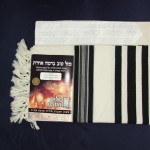Buying a traditional tallit may sound easy, but since most people only shop for a tallit a few times in a lifetime, they don’t know the ins and outs of sizing and choosing the right fabric.
The first task is to decide whether you want to go with wool, cotton or synthetic. Wool is the fabric of choice according to halacha, it looks better and it lasts longer. Acrylic is a decent imitation that offers one advantage: price. An acrylic tallit is typically about half the price of the equivalent wool tallit. Only recently have high quality all cotton tallits been introduced.
Traditional Tallit: How Much Should It Cost?
The price of a traditional tallit depends primarily on the type of fabric you choose and the size of the tallit. Since a Size 36 tallit has half as much fabric as a Size 70, the difference in price is dramatic. You can also expect to pay more for a higher grade of wool.
For a quality wool tallit in an average size (Size 60), expect to pay $75-$125 plus at least $12 for the tzitzit. Prices for traditional wool tallits are often listed without the tzitzit.
At Mishkan Hatchelet, one of Israel’s leading tallit makers, the standard traditional tallit is the Prima A.A. It features a good quality weave and nice finishing work, and it’s available with stripes in a range of colors: black, white, blue, black and gold, black and silver, blue and gold and blue and silver. Mishkan Hatchelet has a longstanding reputation for good quality tallits.

The Chatanim Tallit is their deluxe version. This traditional tallit has a high density weave; discerning tallit buyers will notice that it looks a bit nicer and hangs straighter. The fabric is specially treated to retain whiteness and repel stains. Also, the wool corners are stiff to ensure the tzitzit do not work their way around the corner (tzitzit should stay on the fringed side, hanging down right off the corner).
The Prima A.A. generally comes with the tallit blessing on the atara (depending on the striping color you choose), whereas the Chatanim Tallit has a solid white atara.
Another option is Tallit Hamefoar or Pe’er, which offers all of the special features of the Chatanim Tallit, and is made of an airy, non-slip fabric.
Both the Chatanim Tallit and Pe’er are available with black stripes or white stripes and a range of tzitzit options.
In addition, variations on the traditional tallit include Turkish and Yemenite tallits, Sephardic tallits and the Chabad tallit.
How to Size a Traditional Tallit
Depending on his height (and growth rate) a bar mitzvah boy may choose a Size 45 tallit, Size 50 or a Size 55. These sizes may also fit a short man or a man who prefers a traditional tallit that will cover only his upper back.
For a full-size traditional tallit, most men will opt for a Size 60 or a Size 70, while tall men may choose a Size 80 or even Size 90. Tallit size charts typically list sizes that hang down to the back of the knees. If you want a full-size traditional tallit that hangs down less and is more manageable to wear, go down a size.

